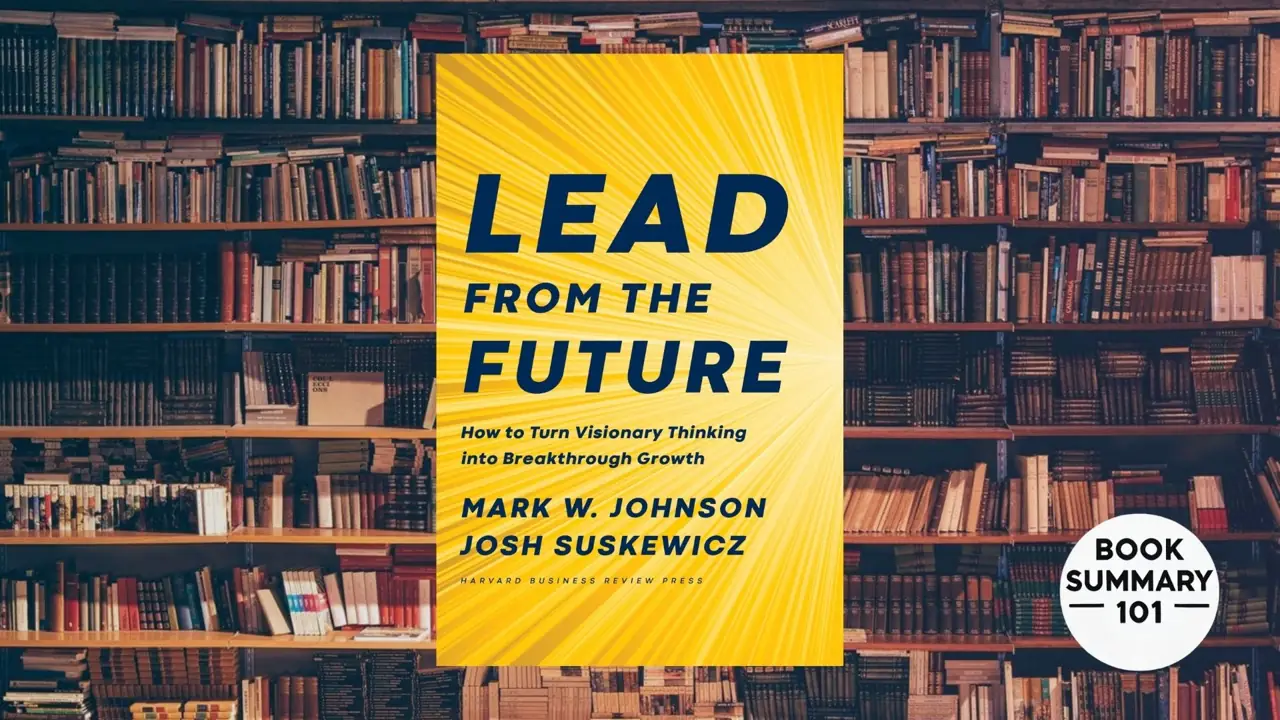today, it’s easy to get stuck focusing on the immediate—the next quarter’s profits, the next marketing campaign, the next product launch. But what if we could think beyond the present? What if we could look five or ten years into the future and make strategic moves today that will transform our tomorrow? This is the premise behind Lead from the Future by Mark Johnson. Let’s dive into what this book has to offer and why it might just be the game-changer your business needs.
Why Read This Book?
Mark Johnson brings a fresh perspective to leadership in this book, urging us to pivot from reactive, short-term planning to proactive, long-term vision. If you’ve been feeling like you’re running in circles or struggling to break through to the next level in your business, Lead from the Future offers a roadmap. Johnson introduces the idea of “Future-Back” thinking, a framework designed to help leaders envision an ideal future and then reverse-engineer the steps to get there. This isn’t about minor tweaks to the status quo; it’s about revolutionizing how you approach strategy.
In Johnson’s words, “Leaders who fail to prepare for the future by crafting a bold vision risk being unprepared for the shifts and innovations that will inevitably change their industries.” So if you’re someone who wants to stay relevant and competitive, Lead from the Future is a must-read.
Key Takeaways
In Lead from the Future, Johnson provides a strategic, actionable approach to creating transformative growth. By envisioning the future and mapping back to the present, you can lead with purpose and clarity, turning lofty aspirations into achievable milestones. The Future-Back approach encourages leaders to be proactive rather than reactive, ensuring that every action taken today is a step toward a bigger, bolder future.
Are you ready to rethink your strategy from the future backward? Start with the vision, and let the steps naturally unfold as you work backward, carving a pathway to the future you want to create.
How Future-Back Thinking Works: A Deep Dive
Mark Johnson’s Future-Back approach is a two-part framework designed to help leaders think and act from a future-oriented perspective. It’s not just about having an idea of where you want to go; it’s about crafting a detailed vision of your future business and strategically plotting the steps to bring it to life. Here’s how each step works, with insights on how you can start applying them today.
Step 1: Envisioning the Future
To truly “lead from the future,” you need a compelling, detailed vision of where you want to go—not just a vague goal like “become a market leader” or “increase profitability.” Johnson encourages leaders to go beyond general aspirations and paint a vivid picture of the future they want to create. This isn’t easy, especially in a world that tends to focus on short-term wins. But it’s essential if you want to set yourself apart.
When you’re envisioning the future, think in terms of specifics:
- What does your company look like in 5, 10, or even 20 years? Picture it like a movie. Imagine the physical workspace, the technology, and the people. Imagine the products or services and how your customers interact with them.
- How has the industry evolved? Think about the changes and challenges your industry might face over time. What trends are just starting now that might reshape the market entirely?
- What customer problems are you solving? Visualize how customer expectations and needs might change. Are they looking for faster solutions, more convenience, or better sustainability? How does your business respond to these shifts?
Johnson emphasizes the importance of making this vision concrete. The more specific you are, the easier it will be to get your team on board. A vague vision doesn’t inspire change; it’s the details that make it feel real and worth working toward.
Real-World Tip: Start with a brainstorming session with your team, mapping out ideas on a large whiteboard or virtual board. Encourage everyone to imagine the ideal state of the company without limits—no idea is too big at this stage. Then, refine these ideas until you have a clear, aspirational future that everyone can get behind.
Step 2: Mapping Back to the Present
Once you’ve crafted a detailed vision of the future, it’s time to reverse-engineer a pathway from that future state to where you are today. This process, which Johnson calls “mapping back,” is a unique form of planning that keeps the future at the center of decision-making.
Mapping back is where many strategic frameworks fall short. Traditional planning models focus on taking steps from the present and moving forward, often resulting in incremental improvements rather than groundbreaking change. But by starting with your end goal and plotting backward, you gain a different perspective—one that prioritizes your big-picture vision rather than just improving current operations.
Here’s how to effectively map back:
- Identify Key Milestones: To reach your long-term vision, you’ll need to achieve certain major objectives along the way. For example, if your vision includes a new flagship product, your milestones could involve phases of product development, customer testing, manufacturing scale-up, and distribution planning. Think of these as the major signposts along the path to your ultimate goal.
- Break Down Milestones into Steps: Once you have milestones, drill down into specific steps needed to achieve each one. This might involve everything from recruiting new team members with specific expertise to securing funding for new technologies. The goal here is to make each milestone actionable and manageable by breaking it down into concrete tasks.
- Establish a Timeline and Metrics: Future-focused thinking can sometimes feel detached from the present, so it’s critical to create a timeline with clear deadlines and key performance indicators (KPIs). Establishing a timeline helps you stay on track and ensures that your team is progressing toward the long-term vision. Use KPIs to measure success along the way—these metrics can serve as markers that help you stay aligned with your ultimate vision.
- Remain Flexible and Open to Change: One of the realities of planning for the future is that things will shift along the way. Johnson suggests building in flexibility and periodically reassessing your milestones to adapt to any unexpected changes. Flexibility in the Future-Back approach ensures that even if specific elements of the vision change, the overall direction remains consistent.
- Align Your Culture with Your Vision: A vision-driven approach can’t succeed without buy-in from your team. Johnson emphasizes the importance of getting everyone on board with your vision and ensuring that company culture supports the long-term strategy. This might involve reshaping company values, incentivizing innovative thinking, and empowering teams to make decisions that align with the future vision.
Real-World Tip: Create a visual timeline or roadmap and display it where your team can see it regularly. This serves as a reminder of the vision and the steps you need to achieve it, helping everyone stay focused on the end goal rather than getting lost in daily tasks.
Real-Life Examples: Bringing Future-Back to Life
Johnson doesn’t just talk theory; he backs up his ideas with powerful real-life examples from industry giants like Apple and Amazon. Apple, for instance, didn’t build its massive ecosystem overnight. Steve Jobs had a clear vision of a “digital hub,” which included interconnected devices and seamless user experiences. This was before the iPod, iPhone, or iPad even existed. By focusing on the long-term vision, Apple was able to work backward to create products that changed the world.
Another great example is Amazon. Johnson talks about how Jeff Bezos didn’t start Amazon just to sell books. Bezos had a broader vision of a “customer-obsessed” company that would eventually touch almost every aspect of retail. With that future-focused vision, Amazon invested in warehouses, delivery logistics, and even cloud computing (now one of its biggest revenue sources) long before the marketplace demanded it. This strategic, visionary approach helped Amazon evolve from an online bookstore into the global powerhouse it is today.
What You’ll Gain
By the end of Lead from the Future, you’ll have a blueprint for applying Future-Back thinking to your own organization. Johnson provides practical tools and exercises to help you work through the process, which makes the book incredibly actionable. You’ll gain clarity on how to make decisions that align with a long-term vision and how to get your team on board with your strategic goals. Essentially, you’ll learn to look beyond the short-term pressures and instead set your sights on truly transformative growth.
Join the Conversation!
Have you ever tried implementing a long-term vision in your business, only to get bogged down by immediate demands? How do you balance the need for immediate results with a desire to build for the future? Lead from the Future gives us a lot to think about, especially in a world that demands quick wins.
Share your thoughts! Have you read the book? What parts of Johnson’s Future-Back approach resonate most with you? Let’s talk about how visionary thinking can drive breakthrough growth in our businesses.
5 powerful quotes from Lead from the Future by Mark Johnson
1. “Strategy is not about making plans for the next quarter; it’s about imagining a future worth creating and figuring out how to get there.”
💡 This sets the tone for the entire book—Johnson pushes leaders to stop obsessing over short-term wins and instead focus on long-term transformation.
2. “The greatest threat to innovation is the comfort of the present.”
💡 A reminder that staying in the status quo might feel safe, but it stifles progress. Breakthroughs happen when we challenge today’s norms with tomorrow’s vision.
3. “If you can’t imagine your company five or ten years from now, someone else will—and they’ll build that future instead.”
💡 Vision isn’t optional. It’s a competitive edge. The leaders who don’t think ahead risk becoming irrelevant.
4. “Future-back thinking is not about predicting the future; it’s about preparing for the one you choose to create.”
💡 This flips the traditional strategy mindset. You’re not guessing what’s coming—you’re proactively designing what you want to build.
5. “A bold vision without a pathway is just a dream. A pathway without a vision is just busywork.”
💡 The magic lies in connecting vision with action. Johnson urges leaders to bridge the gap between aspiration and execution.


